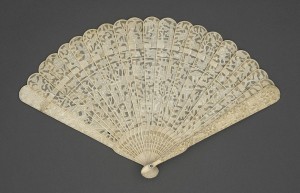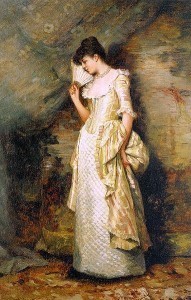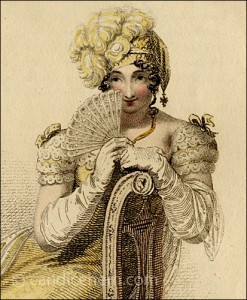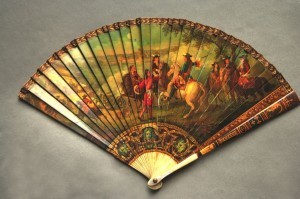Collette Cameron with the Regency version of text messaging–fans!
Hi, all! I have Collette Cameron again. I’m so honored! If you ever wondered how the Regency gentlewomen and men texted and Twittered, well Collette explains how the fan helped with that. This is such a fun post! Here’s some music for you to enjoy while reading through. And now, here’s Collette!
Folding Fans-Historical Text Messaging
The well-dressed Regency lady wouldn’t dream of attending a formal evening affair without her fan in hand. The vintage equivalent of text-messaging, men and women were well-versed in the language of fans. 
Hand fans originated in the Far East, some say Egypt, though the folding fans we are familiar with today are thought to be specific to Japan and were introduced to Europe in the 1500s.
I chuckled aloud at the lessons some ladies underwent in order to learn the proper way to unfurl or discharge their fans. Makes me think of sails on ships and firing guns. And as I’m sure you know, fans had their own romance language.
 If a lady wanted to let a gentleman know he was a handsome hunk, she placed her folded fan against her chin. But should she hit an object, then she was letting him know she was impatient.
If a lady wanted to let a gentleman know he was a handsome hunk, she placed her folded fan against her chin. But should she hit an object, then she was letting him know she was impatient.
Quality fans weren’t inexpensive by any means. These popular accessories were made of a variety of materials. Bone, ivory, mother-of-pearl, tortoise shell, and wood were typically used to make the sticks, while the skin was constructed of paper, lace, silk, or—brace yourselves—chicken skin. Fans could also be made from feathers and were often exquisitely painted.
Regency era fans tended to be less ornate than previous generations, reflecting the simpler styles of gowns. There were different styles and sizes of fans too. The most common and popular fan was the folding fan, typically pleated and painted. This fan consisted of a rivet or pivot at the base which was connect to the guard. You know the long piece along the outside edge of the fan? The sticks (thicker pieces toward the bottom made of the same material as the guard, generally) merged into ribs to which the leaf (actual fabric/material covering the fan) was attached.
The brisé fan, which consisted of decorative sticks (often intricately carved) without pleated leaf, was the next most popular type of fan. It, too, originated in the Orient. The cockade fan, made of paper and having two sticks, opened into a full circle. Only the folding and brisé fan were used for evening events
Smaller fans, called opera fans, were petite enough to fit inside a reticule, though they often hung from a lady’s wrist. This type of fan was preferred during the Regency Era when the pockets of previous generations that easily accommodated larger fans no longer were in style.
I have a couple of gorgeous fans I picked up in Spain several years ago. I can’t imagine using those lovely treasures to send covert messages to my sweetheart across the room. I might put my eye out in the process.
All images are courtesy of Wikimedia commons
Resources:
http://janeaustensworld.wordpress.com/tag/language-of-the-fan/
http://candicehern.com/regencyworld/brise-fans/
http://www.susannedietze.com/dressing-the-regency-lady.html
http://myhandfan.com/language.htm
Collette always makes me laugh! Please check out her latest release! Click on the cover and it will take you to one of the bookstores you may buy it.






